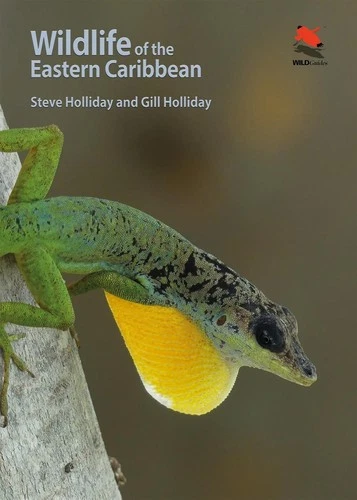Wildlife of the Eastern Caribbean, Steve Holliday & Gill Holliday (Princeton University Press/WILDGuides, 2025) ISBN: 9780691199818 £25
Reviewed by Dr Chris Gibson & Jude Gibson
 I have never been to, nor am I likely ever to visit this region of the world. If I were to, this would be my go-to guide, based on its comprehensive coverage of (some elements of) the Eastern Caribbean fauna. And despite my unfamiliarity with most of the species covered, I am in no doubt that the text is accurate and photos appropriate. That is, with its portability and durability it fulfils its purpose as a field guide.
I have never been to, nor am I likely ever to visit this region of the world. If I were to, this would be my go-to guide, based on its comprehensive coverage of (some elements of) the Eastern Caribbean fauna. And despite my unfamiliarity with most of the species covered, I am in no doubt that the text is accurate and photos appropriate. That is, with its portability and durability it fulfils its purpose as a field guide.
I do however have considerable experience of working on books from the same publisher, so I can review it from that perspective. And I am happy to say it bears the hallmarks of the WILDGuides we all know and use. It is well laid-out in almost all respects, the page design making full use of the page size, with pictures bleeding to the edge, without uniformity on a spread-by-spread basis, even allowing for occasional quirkiness (that I applaud) with for example the crossover of Little Egret onto the Great Egret space.
The pictures are almost universally of high quality and graphically laid out in such a way as to maximize their usefulness. Long gone are the days of criticism that photos are inferior because of lack of comparability between images. And the text we could not fault in terms of unforced errors, almost absent in the volume.
So should I just stop there? Well no, because there are a few things that do rankle, and could have been avoided so easily:
- In some of the lizards and snakes, length has been omitted so there is no knowing how big they area, really quite an important thing to know.
- Page 49 tabulates various abbreviations/icons, but those are used without explanation earlier in the Introduction. Perhaps the tabulation would be better on the end-papers?
- The typographic conventions used on the maps could usefully have been explained somewhere. We also note that on the map on p32, one of the larger islands (St John) is not named.
- There are several uncomfortably large patches of dead white space at the foot of pages. Surely they could have been put to good use? Especially that on p216 where the final entry is the only reference to an entire group, forest lizards or galliwasps. The text entry gives only name, length and distribution, and is crying out for a sentence or photo to explain its difference to other lizard groups.
- And for a publisher that prides itself of textual legibility, how the slim text annotations in grey boxes of some photos (eg p23) got through is inconceivable: in low light they are essentially unreadable. Ditto the blue text headline on black background, p176. And even the front cover text seems unnecessarily subdued and non-contrasty (on our copy, at least), along with the lettering of the WILDGuides logo.
And then of course the ‘elephant in the room’: it serves to highlight the tensions between attracting wildlife-watchers to see and value unique species especially, and in doing so encourage locals to safeguard their economic resource, and the risks of encouraging high-carbon travel that will continue to exacerbate climate change, ironically as keenly felt on islands as anywhere. Commendably the book makes several references to viewing responsibly, although it is a sad fact that the keen listers at which the book is aimed are sometimes the wilfully least aware of the wider consequences of their actions.
Notwithstanding the above, this will no doubt be the essential guide for anyone who visits any of the islands for some time, at least to the groups covered here: birds, mammals, reptiles & amphibians, land crabs, butterflies and Odonata. But since when did the term ‘Wildlife’, as per the title, exclude all plants and most invertebrates?
First published by the British Naturalists’ Association